This was published 7 years ago
Jellyfish and stingers in Queensland during summer: What you need to know
By Catherine Best

A jellyfish warning sign on a beach in Western Australia.Credit: iStock
It's the curse of the tropics – the stinger season, nature's reminder that Australia is home to some of the deadliest creatures on Earth. But just how dangerous are marine stingers, how can you protect yourself this summer and what should you do if you get stung?
What are marine stingers?
Stingers are potentially lethal jellyfish that typically inhabit the waters off northern Australia. The most feared is the box jellyfish or Chironex fleckeri. Distinguished by its large box-like bell and trailing tentacles, the box jellyfish is responsible for about 80 confirmed fatalities in Australia since records began in 1883. The jellyfish's bell grows up to 30cm in diameter and extrudes about 60 tentacles, each measuring up to three metres in length. The Irukandji jellyfish, by comparison, is a pint-sized predator with a transparent bell measuring just 12 to 20mm and four small tentacles. There are numerous Irukandji species and two recorded deaths.
How dangerous are box jellyfish and Irukandji compared to other venomous animals?
"They kick everything else's butt," says jellyfish expert Dr Lisa-ann Gershwin. "The box jellyfish, Chironex fleckeri, has long been considered the world's most venomous animal, it kills people very, very quickly. It is an incredibly lethal species." Dr Gershwin, the director of Australian Marine Stinger Advisory Services, says while Irukandji are more toxic, the box jellyfish are far greater killers. "Drop for drop it takes a lot less Irukandji toxin to actually knock someone down than box jelly toxin, but the box jelly toxin is more likely to kill very, very rapidly."
Where are stingers found?
Box jellyfish thrive in tropical waters and are commonly found in the Northern Territory and as far south as Gladstone in Queensland and Exmouth in Western Australia. They favour warm, clear water, which is why coastal areas sheltered by the Great Barrier Reef are notorious for stingers. Irukandji are less predictable and, contrary to common belief, aren't confined to the tropics. Dr Gershwin says Irukandji species are regularly found off the beaches of Victoria, Sydney and Perth, though stings are less common down south.
When are swimmers most at risk?
The traditional stinger season in the tropics is during the warmer months from November to May. This is when box jellyfish are at their peak, but stings have occurred as early as September. Irukandji activity varies depending on the species. Dr Gershwin says some peak at the height of summer, others are more prevalent in April/May, while another species is common year-round depending on the lunar cycle.
How do jellyfish kill?
A box jellyfish can kill a person within minutes with a potent blast of venom that directly attacks the heart. University of Melbourne toxinologist Dr Ken Winkel describes the multi-tentacled creatures as "a veil of death".
"[They have] millions of preloaded micro-syringes filled with highly potent venom ready to fire on contact and penetrate the skin capillaries. This contrasts with most other venomous creatures that inject a single bolus of venom that has to be slowly taken up into the body's circulation and often acts indirectly to cause body damage."
Dr Winkel, a senior research fellow with the School of Population and Global Health, says Irukandji act indirectly by triggering the nervous system to release masses of stress hormones, which can cause pain, anxiety and potentially lethal increases in blood pressure. Symptoms can take several minutes or hours to present.
How can you protect yourself from jellyfish stings?
Keeping out of the water is a sure-fire way to stay safe, but it puts a bit of a dampener on your holiday. Many popular tropical holiday destinations, including Port Douglas, Palm Cove, Cairns and Mission Beach, install stinger nets during summer to keep box jellyfish out, but they offer no protection from Irukandji, which are small enough to slip through.
In places where there are no nets, it is best to wear a stinger suit. These light-weight, full-body Lycra suits are no fashion statement but provide great protection against stingers (and the sun). If in doubt always check with lifeguards who regularly monitor the water for stingers and will close the beach if there is heightened risk.
What does a sting feel like?
Box jellyfish stings are excruciating. Survivors describe the sensation as like being branded by a hot iron, burned alive, doused in hot oil or struck by lightning. The tentacles leave savage whip-like welts across the skin that can scar for life. Irukandji stings, on the other hand, are often painless and leave no marks (or trace toxin), and thus can be very difficult to diagnose. This possibly explains why the number of reported deaths is so low.
What should you do if you get stung?
If you are stung in the tropics, the Australian Resuscitation Council recommends immediately flooding the site with vinegar. This prevents any non-discharged stinging cells, known as nematocysts, from firing. Pick off any remaining tentacles and seek urgent assistance from a lifeguard or, for severe stings, dial triple-zero. Antivenom is available for box jellyfish stings and is stocked in coastal hospitals and ambulances. For Irukandji stings, vinegar should also be applied and the victim monitored. If symptoms present, medical attention is required.
Sign up for the Traveller Deals newsletter
Get exclusive travel deals delivered straight to your inbox. Sign up now.